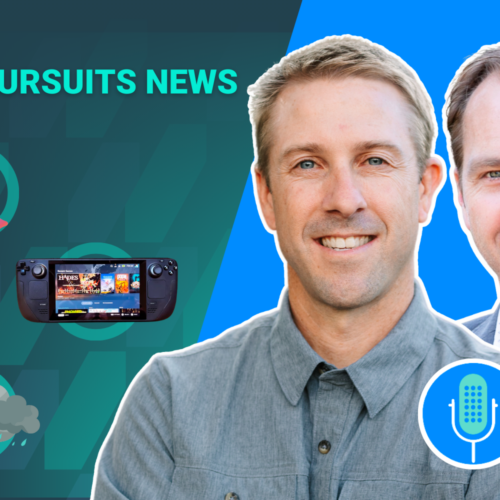Podcast 44: Content Marketing and Traffic Tips from Neil Patel

When you buy something through one of the links on our site, we may earn an affiliate commission.
When I first started the Niche Pursuits podcast, I never considered reaching out to “big name” interviewees. I was green, but luckily already knew from previous networking some pretty interesting people that I go could interview for my show (such as Chris Guthrie and Pat Flynn).
However, Perrin and I have started to reach out a bit more lately to interview some more well known individuals such as Rand Fishkin from a couple of weeks ago.
Well, today is another one of those “big names”! We had the chance to interview Neil Patel of QuickSprout.com.
Neil is very well known for the products he's built (Kissmetrics, CrazyEgg, and others) and for the traffic strategies he's implemented on large websites such as TechCrunch.com and Amazon.com. When it comes to content marketing and traffic experts, Neil is right there near the top of the list.
So, I hope you enjoy the interview as we discuss his entrepreneurial background, traffic strategies, infographic strategies (that still work), and much more.
Enjoy!
Neil Patel Interview
For the entire interview, please listen to the audio recording below. However, if want to quickly read over what was covered, I've written down the questions and answers in an abbreviated format below:
What is Neil's entrepreneurial background?
Neil started when he was roughly 16 years old. He started online because that is what he knew, and he wanted to make money.
Neil is now focusing most of his time on Kissmetrics. What kind of success is he having with Kissmetrics?
The software is doing very well. The site is getting over 600,000 visitors per month and the average customer is paying in the thousands of dollars per year for the product.
How did Neil found and fund Kissmetrics?
Hiten Shah and Neil Patel founded Kissmetrics together. They have also received several rounds of funding. The reason they wanted to get funding for this business rather than bootstrap the company was to grow it much faster. They felt like the life time value of the customer and growth potential made venture capital the best route to grow the business.
What business does Neil advise someone to get into that is just starting out?
You should go after your passion. In addition to passion you also need to be solving a problem. So, pick a market you are passionate about and solves a problem in a big enough market.
What are some of Neil's top traffic strategies?
Content marketing, social media, and SEO.
When starting out, pick the traffic strategy that you are best at; rather than focusing on all the tactics.
What are some content marketing strategies that people can implement today?
1. Blog on a consistent basis. Pick a schedule and stick with it (daily, weekly, bi-weekly, etc).
2. Write evergreen content
3. Make your content very detailed. Give away the farm, don't hold anything back.
4. Don't expect your content to promote itself. Find a list of 100 websites owners that write on similar topics that are not competitors. Then email them and ask them to Tweet about it (don't ask them to link to it). You should get about a 5 percent conversion rate.
Are links important, and where are the links coming from if you don't ask for them?
Yes, links are important.
But its difficult to get links by asking for them. So, by getting people to mention them on social media, you can then hope to get more natural links as more people see the content.
What types of people should you reach out?
Stick with your peer group for the most part.
How can someone that is just starting out use Infographics to grow their site?
First, its important to have a great design. You can find a good designer on Dribbble.com; and it will cost around $500 – $1000 for a great infographic.
Second, information is everything. You need to have great data through your own research or by hiring someone. The infographic should only have 5 or 6 main points; keep it simple.
Once your infographic is done it needs to be promoted. Put the infographic on your site. If using WordPress you can use the plugin called WP-Embed Code Generator. This will create an embed code that others can use to use the infographic on their site with a link back to yours.
Then go tweet about it and email contacts in your space to help promote.
This is one of the main strategies that Neil used to grow the Kissmetrics blog.
How long would it take someone just starting out to build a good sized audience using the info-graphic technique?
If you are blogging weekly, it will take you at least 6 months to build an audience.
Is Neil still using the outreach tactics you've mentioned on previous interviews and guides for link building?
Yes, it still works. Now Neil just tells people to try to reach out to 100 people, simply because most people get overwhelmed reaching out to 200 or more people.
How is content marketing for a large site like TechCrunch different than for a newer site?
For a bigger site, you don't need to do link building. Its actually easier for a larger site because you can just focus on fixing minor issues.
What are Neil's thoughts on Private Blog Networks?
He's not real familiar with them. He thinks Google will devalue the links once the domain expires.
Other Tactics?
Guest posts can be a great way to get quality links. If you can communicate with other existing writers on the site; you can eventually ask for an introduction to the editor and will be much more likely to get approved as a writer.
Where to Follow along with Neil?
QuickSprout.com and NeilPatel.com
Listen to the Podcast
If you enjoy the podcast, please feel free to stop by iTunes and leave a review here. Thanks!
My top recommendations

















24 Comments
Conversation
Great interview , does google really devalue the links once the domain expires ????
In my opinion, no. At least not completely, and the real answer could depend on what has happened to the domain history etc.
Keep in mind, too, that Neil mentioned he’d never heard of PBNs, so he may not have seen how they affect sites in a real-world application.
Thanks, i have another Q for you guys, what do guys think about all this https vs http, you think is worth it to use https in the long run.
It will be ns to see a case study about that 🙂
Hey Isaac,
After some researching about the topic, I’ve decided that https is not worth the hassle, at least for now.
Here is one of the case studies:
blog.searchmetrics.com/us/2014/08/29/https-vs-http-analysis-do-secure-sites-get-higher-rankings/
Thanks for the link to this case study Michael!
No problem, Glenys
Hey Isaac, My vote goes to “no”, too.
There are too many data points out there that prove that the expired domains are still valuable.
I’ve read Neil’s blog for a while and while I feel much of his ideas are more relevant for larger sites, I enjoy his direct and positive style. What do you think about his idea of blogging on a schedule for niche blogs?
I’m going to answer in the frame of niche site-building. So keep that in mind, because, as you said, Neil was talking more about larger sites.
Anyway, I’ve had plenty of success with INconsistent blogging. For all of my personal sites (which are doing very well right now), I publish in batches of 5, 10, 15, or even 20 at a time.
However, Spencer and I have been scouting and buying sites that are earning good money–like, in the thousands–with NO link-building (seriously). One of the only common denominators with these sites is lots of content on a consistent schedule. Now, that might be because a consistent schedule just ends up producing a lot of content, which we know Google likes, or it might be because Google likes to see fresh content every so often.
In short, we’re still investigating, and both work, but there does seem to be something to the consistently scheduled blogging.
Perrin, for those no link-building $ sites, how often do they publish fresh content like?
Daily, every other day, or weekly?
I am wrapping up some niche sites, and like to have my own schedule too.
Thanks!
The ones we’ve seen usually start with a large batch (30 or so) and then publish weekly. That’s not a golden rule or anything, but that’s what we’re seeing.
Thanks for the insight Perrin. I can affirm that regular blogging to build content can do wonders; I posted daily for a couple of months on one of my other blogs and page views doubled each month (e.g., 20k to 40k). I’m now experimenting with posting only around 10 time a month to see if the growth continues or levels off.
Good to hear about your findings Mike. We hear so many mixed messages about publishing schedules.
With time, Neil has become one of the most loved SEO experts in the industry.
His blog QuickSprout is my last destination to learn more about SEO and to get more business ideas.
Thanks for bringing him on the board and sharing these awesome tips. 🙂
Great podcast Spencer!
I do have a question though.
During the podcast you brought up PBN’s to Neil Patel. He said that he did not have any real knowledge of it. However, he said that he did not think it was a good idea because old domains would de-value ones links.
It seemed that you did not push the issue on that topic. Why is that? I know you are in partnership with Rank Hero, or may even own it.
My question to you: Do you recommend PBN’s or Do you not. If I remember correctly, you agreed with him about the Links being de- valued, but at the same time you promote Rank Hero.
It is a bit confusing, and just want to get your thoughts on using PBN’s or not to use PBN’s
Thanks!
I did not agree with Neil in the podcast. I simply asked his opinion and since he didn’t have any real experience with it, I didn’t ask any deeper. Also, Neil was on a very tight schedule for the podcast, so I simply didn’t have time to dig deeper into questions that perhaps I would have liked to.
Bottom line is that I personally use PBNs (including rank hero) for my sites and it works really well. For some sites I have done nothing but use expired domains for links and they are ranking well (and earning money) in Google.
hmm Maybe I should have read the Thread before asking my question.
Great interview. I really like this one.
I found your summary of the podcast really useful Spencer; it saves going back through the audio searching for a particular point that was covered.
I particularly liked the 4th point Neil listed in answer to your question about content marketing strategies, the one about contacting 100 bloggers to seek tweets rather than links. A 5% conversion rate provides a good metric to shoot for.
Definitely…thanks Glenys
How can someone that is just starting out use Infographics to grow their site?
” First, its important to have a great design. You can find a good designer on Dribble.com; and it will cost around $500 – $1000 for a great infographic. ”
Most people who are just starting out won’t have $500-$1000 to spend. The problem with interviewing the big hitters is that they are not in-tune with the small guys.
Yep, I agree. They seem to think everyone is a large agency like Kissmetrics. I always try to gear the questions, “for someone just starting out”…but perhaps some of these guys have forgotten what its like “just starting out”.
Certainly, there’s levels to infographics, perhaps one could go “Toyota” until they can afford “Lexus”.